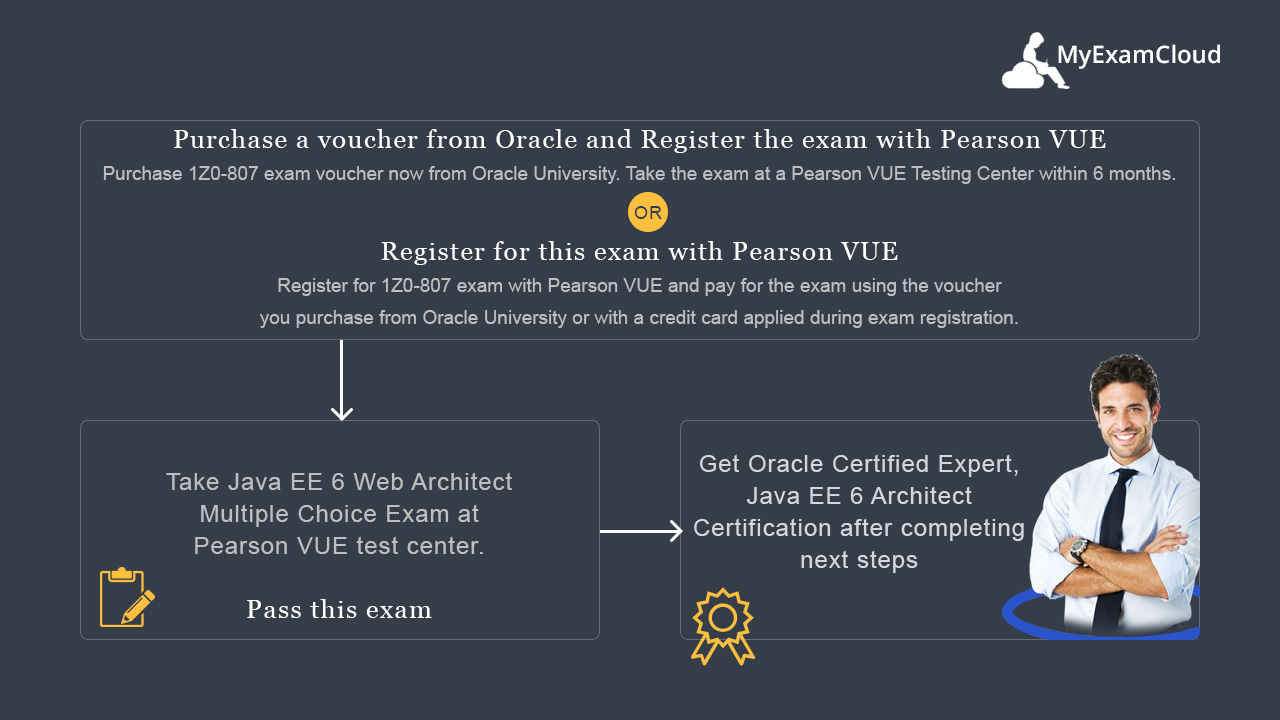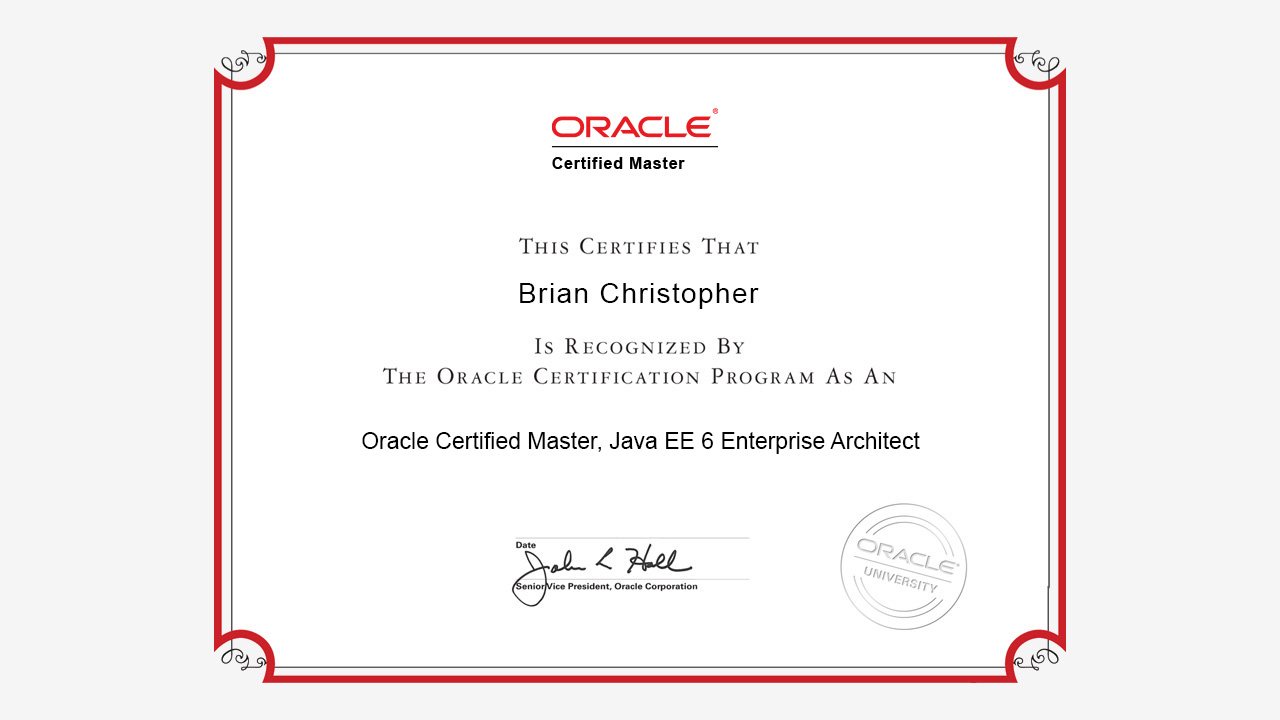21 OCMJEA 6 Practice Questions - Free
You can access 21 OCMJEA 6 Practice Mock Exam e Questions from MyExamCloud Exam Simulator.
Take Free Practice Testfor Oracle Certified Master Java EE 6 Enterprise Architect Certification
MyExamCloud OCMJEA 6 practice tests helps you to pass the Java EE 6 Enterprise Architect Certified Master exam in first attempt. Prepare with one of the best OCMJEA 6 Study Course developed by Java Certified Experts. 100% Test Pass Guarantee.
MyExamCloud 1Z0-807 mock exams are available online at MyExamCloud simulator. This course contents can be accessed from PC, Mac, iPhone®, iPad®, Android™ Device. Mobile Apps available on iTunes and Android stores.
Inside MyExamCloud's OCMJEA 6 Practice Course
Set Goals on OCMJEA 6 Assignment exam topics
(MyExamCloud PPA Tracker)
OCMJEA 6 practice mock exam tests your basic architecture skills in each exam objective. (MyExamCloud Practice Exam)
MyExamCloud OCMJEA 6 practice test offers 6 practice mock exams with detailed explanation and answers.
MyExamCloud OCMJEA 6 training simulator offers two quiz tests that covers all real exam topics
MyExamCloud OCMJEA 6 training simulator also offers 3 review quiz exams that covers all real exam topics
MyExamCloud OCMJEA 6 training lab offers two study notes (eBook) that covers all real exam topics
Study mode to access topic based questions
MyExamCloud OCMJEA 6 exam questions & answers, along with exhaustive explanations.
MyExamCloud reports to assess performance history, strengths & weaknesses against each topic
MyExamCloud goal tracker used to track your goals and shows how you accomplish your goals
MyExamCloud focus lab to pinpoint your weak areas, it will help you to complete your self-preparation
MyExamCloud platform gives you unlimited lifetime access, any where, any time and any device (Smart Phones / Tablets)
OCMJEA 6 simulator providing you with complete preparation material for Java EE 6 Enterprise Architect Certified Master Exam, along with mock and quiz questions. Each and every content on MyExamCloud have been created & validated by highly qualified Java architects. They are highly qualified individuals, who have 15 years of experience in Java EE technologies.
The OCMJEA 6 (Java EE 6 Enterprise Architect Certified Master) Practice Tests guide you the Enterprise Architect’s roles, responsibilities and deliverables, Identify non-functional requirements (NFRs), common problems and solutions, translate business requirements into an architecture, best design choices in architecting the client, web, business, integration and data tiers, apply various evaluation criteria to choosing architectural elements & patterns, tools, servers and frameworks.

| Number of Questions: | 60 Questions |
|---|---|
| Exam Duration | 150 Minutes |
| Passing Score: | 71% |
| Exam Format | Multiple Choice (which can have single or multiple answers) |
| Validated Against | Java EE 6 |
| Exam Price | Price May vary from Country to country. Refer Oracle site for latest pricing. |
The real exam is a computer based test provided by pearsonvue and it can be taken from any local test centers in your country.
Set The New Java Standard With Java EE Architect Certification. The Java EE architect certification exam is a decent approach to distinguish your resume. Applicants who consistently guarantee they are up to speed on the most recent advances and hold significant certification in their picked technological advancements increase the value of their organizations. Any Java EE developer interested in architect career can take this exam.
The following practice question is taken from MyExamCloud OCMJEA 6 Study Plan.
|
Question: You have completed development activities of Java EE insurance application and ready for production. During production deployment you noticed that your web server residing at DMZ, serves only static contents and other components are running in the application server. Which of the following statements are TRUE about moving static content into a web server? [ Choose two ] ChoicesChoice A :The inner firewall will allow only web server requests, so application server is hacker safe from internet zone. Choice B :Moving static content outside application server is not recommended since there will be a network traffic between web server and application server. Choice C :This will decrease the performance. Choice D :This will increase the security. |
Answer and Explanation:Choice A and Choice D are correct.In computer security, a demilitarized zone (DMZ), based on military usage of the term but more appropriately known as a demarcation zone or perimeter network, is a physical or logical subnetwork that contains and exposes an organization's external services to a larger, untrusted network, usually the Internet. The purpose of a DMZ is to add an additional layer of security to an organization's Local Area Network (LAN); an external attacker only has access to equipment in the DMZ, rather than the whole of the network. So web server residing at DMZ will alone can access application server and it increase the security. |
You can access 21 OCMJEA 6 Practice Mock Exam e Questions from MyExamCloud Exam Simulator.
Take Free Practice TestWithin 30 minutes of completing your OCMJEA 6 Certification exam, you will receive an email from Oracle notifying you that your exam results are available in CertView. If you have previously authenticated your CertView account, simply login and select the option to "See My New Exam Result Now."
If you have not authenticated your CertView account yet at this point, you will need to proceed with your account authentication.
Authentication requires an Oracle Single Sign On username and password and the following information from your Pearson VUE profile: email address and Oracle Testing ID. You will be taken to CertView to log in once your account has been authenticated.

The reason for taking Oracle Java Certification is to differentiate general programmers from certified experts. You may get additional benefits like getting a good job, salary hike, designation changes, role changes and higher promotion.
Stand out from the millions of Java crowd. Increase your marketability with OCMJEA 6 Certification on the most used programming language in the world - Java.
The certification empowers in driving Java EE Architecture for enterprise applications. OCMJEA 6 certified architects can easily evaluate various design options, frameworks, software COTS components, etc.
Congrats, you have successfully scheduled your Java Certification exam.
The real exam questions assumes the following:
|
Application Design Concepts and Principles
Common Architectures
Integration and Messaging
Business Tier Technologies
Web Tier Technologies
Design Patterns
Security
|

I'm delighted to see that you guys providing assignment exam preparation solution for architect and developer exams. Excellent material !!!